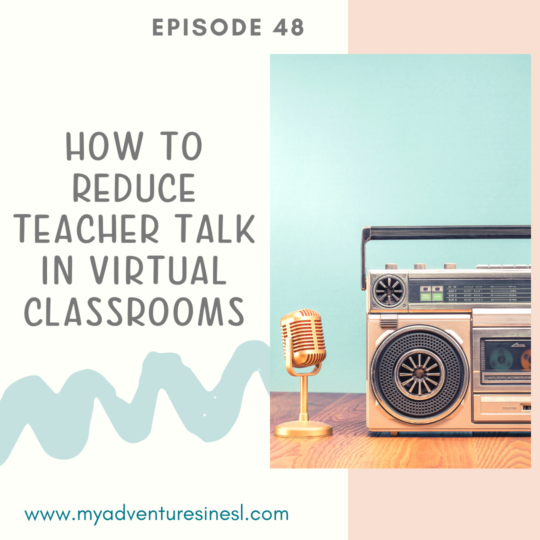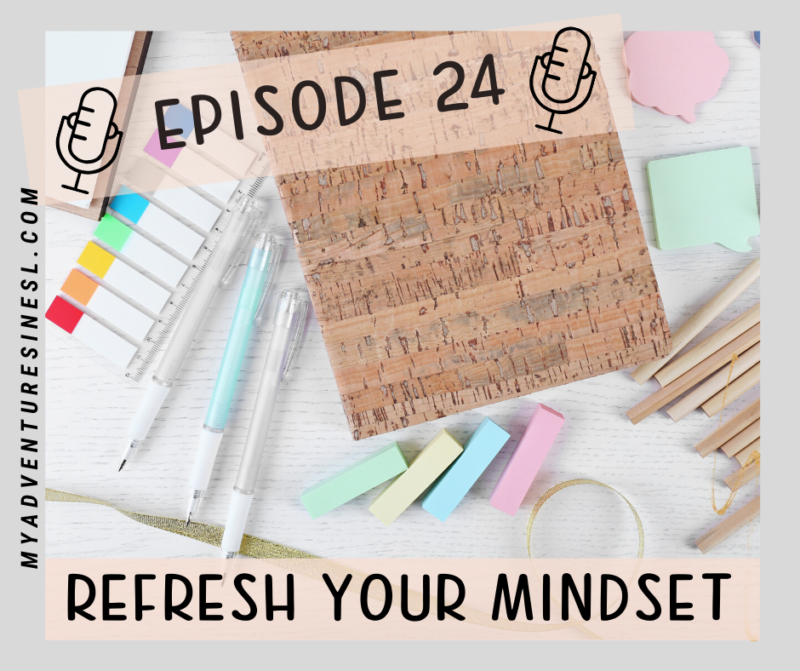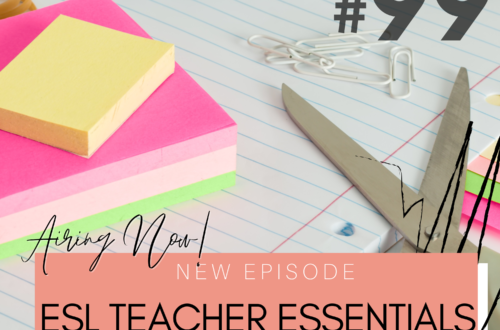
Too Much Teacher Talk? Here are some Strategies!
Hello, welcome all-star teachers to the My Adventures in ESL podcast. Now, as we jump today’s topic, I would like for you to reflect on the week. What were some high points of the week that you are proud of? And I also want to thank all of the Master Planners who have joined the program. I am so excited to be working with you this upcoming school year. Now, as you know, every week I want to highlight a teachers win and a win can be big.
It can be small, it could be medium size. And I want you to celebrate your wins throughout the week, and I want to celebrate with you. So if you have a win that you want to share, just email me at millie@myadventuresinesl.com. And this week’s winner goes to all of the educators that are in the ESL teacher master plan. This past month, I’ve launched a program for ESL teachers that supports them in planning for the upcoming school year.
Whether that’s virtual or in-person, we are walking through how to create an engaging curriculum. I’m giving them all the tools and a roadmap to create an engaging curriculum.
In addition to that, we are meeting each week to go through any roadblocks and any feedback they might have to get ideas going. And we’re going to be having ongoing professional development throughout the school year. So I want to personally thank all of those educators who committed and who are invested in this program. I cannot say enough how excited I am to be working with you this upcoming school year. Now, in today’s podcast, we are going to be talking about the question, and that is too much teacher talk.
Sometimes we ask ourselves this, am I talking too much in the classroom? And we’re going to be talking about how you can plan for more student talk in virtual classroom settings and or in-person classroom settings. Now, when I ask the question, what would you like to do less of in your ESL classroom? One of the top answers I get back is I would like to talk less and the students talk more When you are doing most of the talking that means that you are doing the majority of the work and you’re doing the majority of the thinking. Now, doing the majority of the talking as an ESL teacher limits the output. And that is so important to language learning for our students. And I get it, I know that I constantly have to remind myself, as I’m teaching, to allow the students to talk and engage. I mean, is that surprising? Right. I’m here on this podcast talking to you all now, but most of us have had that thought while we’re teaching.
Am I talking too much? Because it feels like I’m talking too much. And I remember asking myself this question and looking out at my students, and it was just silence. I said to myself, am I talking too much? And then I looked out in the classroom. The students were just looking at me and I remember thinking, OK, this is awkward and uncomfortable.
So I knew that I had to make a change. Many of us are struggling with the trust around letting the students talk. Some of us might feel as if we are talking that we are in control of the lesson or the classroom. Now, that is another mindset block that sometimes we have to work through, and that’s what we’re going to do today.
So the first step in reducing teacher talk time with my language learners was to become aware that I was doing the majority of the talking. That’s the roadblock. That’s the first big hump to get over because some people are talking, talking, talking, and they don’t even realize it. Now, being aware is the first step in moving towards any type of growth. I also was really uncomfortable with the idea of silence. Now I use silence from my students as a tool to assess the students.
At first I was just using that as a tool to say, OK, maybe they don’t know what’s going on or maybe I’m doing something wrong. But when I started thinking about that, I was like, you know what? Let me use silence as a way to assess the students.
Now, I would then encourage students if I was talking too much or if I was in the middle of a lesson and I realized, hey, I realize I’ve been talking too much.
Let me check and do a quick assessment. I would then encourage the students to do a turn and talk and then listen in on their conversations. That is another way that you can do a formative assessment with your language learners. And then after I started doing that, I started thinking about, are my students showing me, are they discussing on a rethinking, are they sharing? And I started doing this strategy and this allowed the students to think and then write down all of their thoughts. Then they discussed, and they modified their thinking and changed it up, speaking with a partner.
These are all strategies that I implemented in my classroom after realizing that I’m talking too much. As you can see right here, I started getting very intentional about integrating activities where I am having the students doing the talking in the classroom. Now, after they did this activity, I would sometimes have the students share their thinking in the classroom. So in this example that I just gave before, the students are talking and I’m not talking, I’m listening in on their conversations.
This led me to be very intentional about where and how much student talk I was including in my lessons. I even took things a little bit further in my lessons and started putting a timer on a PowerPoint slide to keep me aware as an educator how much teacher talk I was doing.
And when that timer went off, that gave me the opportunity to say, OK, you’ve been talking for five minutes, it’s time to let the students do the talking. At this point.
So here’s what I want you to do. I want you to first take the step and cure too much teacher talk time blues, and I want you to become self aware. One of the ways that you can become self aware is to think
about can you do this by creating a log of how much you’re talking. Meaning that you do a lesson and you set a timer and you see how much you’ve been talking versus how much the students are talking in the classroom.
So the first step is to become aware.
And then I want you to remind yourself that it’s OK to be silent in the classroom as a teacher . It’s OK to allow your students the time and space to think. You can incorporate this by doing engaging activities such as think, pair, share, or use the model of being pair share that I use for my students that allows them to discuss and rethink.
In that model, I also give them time to brainstorm their thinking before they discuss what a partner. I also want you to start becoming more intentional about incorporating student talk time into the lessons, this can be done by simply placing timers on the slides to limit your talk time as a teacher and putting slides in your lessons where you are promoting student talk time like the think-pair-share.
Now, here are your next steps. I want you to reflect on teacher talk time for the last school year and decide if you need to implement any of these strategies. And if you do, make sure that you start by doing so, by becoming aware and more intentional. I would like to know how you are reducing your teacher talk in your classroom.
You can share your strategies by joining our free Facebook community.
Just go to Facebook, type in My Adventures in ESL and you will see our Facebook community. So come on over to the community. We would love to know how you are reducing teacher talk in your classroom. Once again, thank you for dropping in on this episode. You are amazing and fantastic and I hope that you have a wonderful




